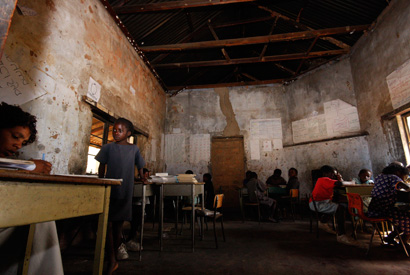Today we were invited to attend a community meeting, organised by the school PTA (Parent Teacher Association), to discuss the exact needs of the school.
Fifty people walked to the present school for the meeting, and we posted comments on Twitter as they spoke. They were unanimous about the order they need things to be completed.
Firstly, they told us, they need to build a classroom. The school was supposed to vacate its current premises in August last year, and there’s a good chance that by the time this August comes round, their stay of execution will have expired. They can move the children to a temporary shelter – a basic wooden construction in a field – for classes, but they need a building to store their books and records.
These aren’t just school documents that need a safe, dry home. The headmaster also organises community volunteers to make regular rounds of the village to perform basic health checks and keeps files for this vital function. He lives outside the community, in Kalomo, and cycles every day to work. Transporting what he needs every day would be impossible.
For that reason, the school building should, ideally, also have a small office.
The current plan
Initially, the school will be just this building and the temporary shelter for the older children.
The next priority is for teacher housing. They cannot attract permanent, government trained staff unless they can offer them a home within easy reach. Two trained teachers currently volunteer full time at the school, and live in a shack with no door in the compound.

It's not much of a classroom, and soon the school won't even have that
After that, they say, the most important thing is a borehole. Without water, the children find it have to waste time fetching water difficult to study, the live-in staff have nothing to drink and it’s impossible to maintain anything kind of basic hygiene.
To complete the school will take approximately 7,200 man hours of skilled and unskilled labour. To get in contractors to finish the construction, the wages would be around 10,000 Kwacha per hour per worker. That’s approximately £1.20 (or $2), which is the average daily income in Zambia. There’s no way Simakakata can afford to pay.
The women and children will also contribute by providing food and fetching water to the build site.
If making the remaining materials – doors, iron sheeting for the roof, window frames and glass - was possible, these people would do it.
Until they have them, they cannot get further investment from the government, and the quality of teaching will inevitably suffer.

The crumbling brickwork of the classroom doorway
A year ago, there were no qualified teachers at Simakakata school. The difference that trained staff have made to the quality of education and the lives of the children and their prospects has been indescribable. Nearly all of the children are behind the standards for their grade, though, and only with money for new buildings can their work here improve.
They need your help, please follow the story and donate.


